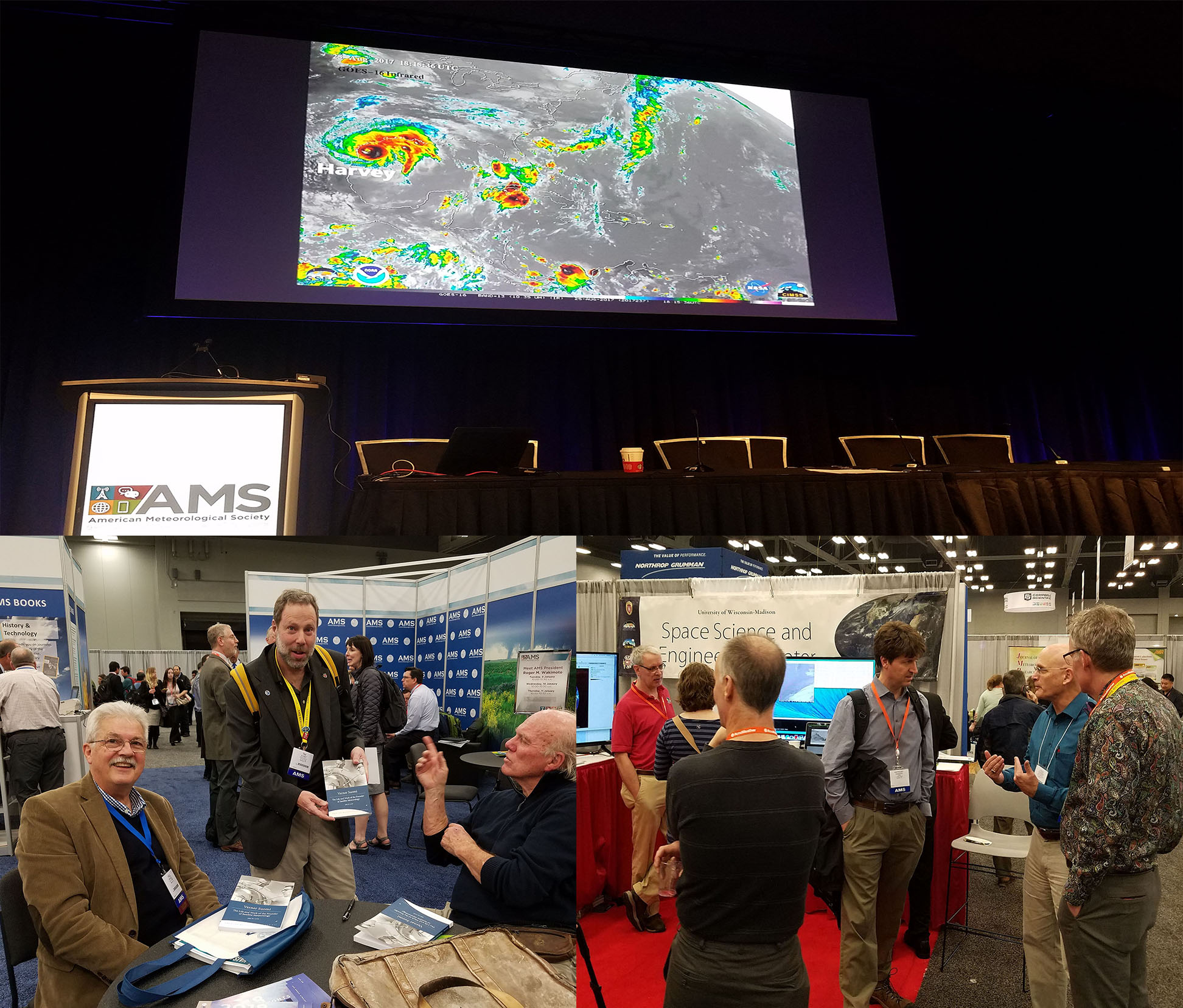
[ Archive ]

 |
CIMSS-NOAA Weekly Report [ Archive ] |
 |
ASPB AND CIMSS WEEKLY HIGHLIGHTS FOR THE WEEK ENDING JANUARY 12, 2018
IN THE PRESS:
ITEMS FOR THE ADMINISTRATOR:
ITEMS FOR THE ASSISTANT ADMINISTRATOR:
ITEMS FOR THE OFFICE DIRECTOR, STAR:
WMO Global Cryosphere Watch Steering Group Meeting: The World Meteorological Organization (WMO) Global Cryosphere Watch (GCW) Steering Group held its fifth meeting in Oslo, Norway, 10-12 January 2018. Various GCW working group meetings were held earlier in the week. The meetings were hosted by the Norwegian Meteorological Institute ("Metno"). Jeff Key is a member of the Steering Group; he gave presentations on GCW products, information, services, and regional activities. (J. Key, E/RA2, 608-263-2605, jkey@ssec.wisc.edu)
UW-Madison SSEC/CIMSS/ASPB Participation at the 2018 AMS Conference: Representatives from the Cooperative Institute for Meteorological Satellite Studies (CIMSS), Space Science and Engineering Center (SSEC), and the NOAA Advanced Satellite Products Branch (ASPB) participated in the 98th Annual American Meteorological Society (AMS) meeting held the week of January 6, 2017 in Austin, TX. GOES-R/JPSS Short Courses were conducted on Saturday January 6 and Sunday January 7. There were over 50 oral presentations and posters by SSEC, CIMSS, and ASPB staff as part of the Student Conference, 14th Symposium on New Generation Operational Environmental Satellite Systems, Third Symposium on Multi-scale Predictability: Data-model Integration and Uncertainty Quantification for Climate and Earth System Monitoring and Prediction, 27th Symposium on Education, A Special Symposium on Plains Elevated Convection At Night (PECAN), 6th Symposium on Aviation, Range, and Aerospace Meteorology, 34th Conference on Environmental Information Processing Technologies, 22nd Conference on Satellite Meteorology and Oceanography, 22nd Conference on Integrated Observing and Assimilation Systems for the Atmosphere, Oceans, and Land Surface (IOAS-AOLS), 20th Conference on Atmospheric Chemistry, Sixth AMS Symposium on the Joint Center for Satellite Data Assimilation. Many participated in board, committee, and other side meetings on a host of topics. Selected ‘one-page’ summaries of NOAA funded presentations will be posted at http://www.star.nesdis.noaa.gov/star/meetings.php with the assistance of Ralph Ferraro (Chief, Satellite Climate Studies Branch). In addition to the broad spectrum of presentations, SSEC once again sponsored a booth on the Exhibit Hall floor. The booth presence has occurred for at least 20 consecutive years. The highlight of the booth this year was a Satellite Data Ingestor (SDI) that processed a GOES-16 GRB signal in real time. The GRB signal came from the antenna in Madison and was piped to the meeting in Austin via Internet. The SDI-decoded signal was displayed in real time in the booth via McIDAS-X and AWIPS. Demonstrations of McIDAS-V and RealEarth were also prominent in the booth. The Booth also serves as a meeting space between SSEC/CIMSS scientists and colleagues in industry, education, and government (W. Feltz, CIMSS/SSEC, 608-265-6283, wayne.feltz@ssec.wisc.edu; S. Ackerman, CIMSS/SSEC; S. Lindstrom, CIMSS; T. Schmit, E/RA2, 608-263-0291, tim.j.schmit@noaa.gov; Michael Pavolonis, E/RA2)
 (Click image to enlarge)
(Click image to enlarge)
Figure caption: 2018 AMS ASPB/SSEC/CIMSS Participation Collage.
ITEMS FOR THE DIVISION CHIEF, CoRP:
GOES-16 Weighting Functions On-Line: The Geostationary Operational Environmental Satellite (GOES) near-real-time weighting function web page hosted at the Cooperative Institute for Meteorological Satellite Studies (CIMSS) has been updated with the GOES-16 Advanced Baseline Imager (ABI) as the GOES-East. As part of planned changes to the web page, a peak pressure for each band's weighting function is also now included on the plots. The web page is used by operational meteorologists and primarily used for training purposes for National Weather Service, including in foundational satellite training. The web page can be accessed at http://cimss.ssec.wisc.edu/goes/wf/. (M. Gunshor, CIMSS, 608-263-1146, T. Schmit, E/RA2, 608-263-0291, tim.j.schmit@noaa.gov, S. Lindstrom, CIMSS)
(Click image to enlarge)
Figure caption: Weighting function plots calculated from the Wallops Island radiosonde on January 5, 2018 at 00UTC for all 10 Infrared bands of the GOES-16 ABI, now operational as GOES-East.
Presentations on GOES-16 applications given at McGill University & Environment Canada: Bob Rabin of the NOAA/National Severe Storms Lab Norman, OK and the Cooperative Institute of Meteorological Satellite Studies (CIMSS) gave presentations in the Atmospheric and Oceanic Science Department at McGill University and the Environment and Climate Change Canada (ECCC) Quebec Weather Center, both in Montreal, Quebec, Canada. The later Webex presentation was recorded. The presentation gave a history of the U.S. geostationary satellite program, an overview of GOES-R ABI and GLM measurements, and review of current research including estimating divergence above thunderstorms using satellite winds from the current GOES-R algorithm and from a new optical flow approach. (R. Rabin, NOAA/NSSL and CIMSS, 608-264-5325/405-366-0583)
VISITORS:
NEXT WEEK:
LOOKING AHEAD:
| Archived Weeklies Page | Submit a report item |